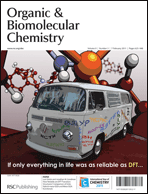This month sees the following articles in OBC that are in the top ten most accessed:-
A facile method for the synthesis of oxindole based quaternary a-aminonitriles via the Strecker reaction
Yun-Lin Liu, Feng Zhou, Jun-Jie Cao, Cong-Bin Ji, Miao Ding and Jian Zhou
Org. Biomol. Chem., 2010, 8, 3847-3850, DOI: 10.1039/C0OB00174K, Communication
Chiral Separation by Enantioselective Liquid-Liquid Extraction
Boelo Schuur, Bastiaan J. V. Verkuijl, Adriaan J. Minnaard, Johannes G. de Vries, Hero J. Heeres and Ben L. Feringa
Org. Biomol. Chem., 2011, 9, 36-51, DOI: 10.1039/C0OB00610F, Perspective
Sequential one-pot combination of multi-component and multi-catalysis cascade reactions: an emerging technology in organic synthesis
Dhevalapally B. Ramachary and Sangeeta Jain
Org. Biomol. Chem., 2011, Advance Article, DOI: 10.1039/C0OB00611D, Emerging Area
Asymmetric organocatalytic Michael–α-amination sequence for the construction of a quaternary stereocenter
Alaric Desmarchelier, Jérôme Marrot, Xavier Moreau and Christine Greck
Org. Biomol. Chem., 2011, Advance Article, DOI: 10.1039/C0OB00751J, Communication
Oxidative amide synthesis directly from alcohols with amines
Cheng Chen and Soon Hyeok Hong
Org. Biomol. Chem., 2011, 9, 20-26, DOI: 10.1039/C0OB00342E, Emerging Area
Copper catalysis in the construction of indole and benzo[b]furan rings
Sandro Cacchi, Giancarlo Fabrizi and Antonella Goggiamani
Org. Biomol. Chem., 2011, 9, 641-652, DOI: 10.1039/C0OB00501K, Perspective
Efficient total synthesis of (-)-stemoamide
Toshio Honda, Tomoha Matsukawa and Kazunori Takahashi
Org. Biomol. Chem., 2011, 9, 673-675, DOI: 10.1039/C0OB00850H, Communication
Synthesis of difluoroaryldioxoles using BrF3
Youlia Hagooly, Michael J. Welch and Shlomo Rozen
Org. Biomol. Chem., 2011, 9, 902-905, DOI: 10.1039/C0OB00571A, Paper
Transition metal mediated construction of pyrrole ring on 2,3-dihydroquinolin-4(1H)-one: synthesis and pharmacological evaluation of novel tricyclic heteroarenes
Mohosin Layek, Appi Reddy M., A. V. Dhanunjaya Rao, Mallika Alvala, M. K. Arunasree, Aminul Islam, K. Mukkanti, Javed Iqbal and Manojit Pal
Org. Biomol. Chem., 2011, Advance Article, DOI: 10.1039/C0OB00771D, Communication
Practical access to highly enantioenriched quaternary carbon Michael adducts using simple organocatalysts
Thomas C. Nugent, Mohammad Shoaib and Amna Shoaib
Org. Biomol. Chem., 2011, 9, 52-56, DOI: 10.1039/C0OB00822B, Communication
Why not take a look at the articles today and blog your thoughts and comments below.
Fancy submitting an article to OBC? Then why not submit to us today or alternatively email us your suggestions.
Comments Off on Top ten most accessed articles in December












